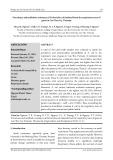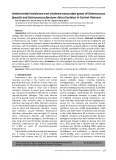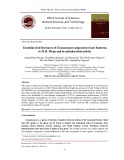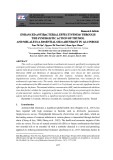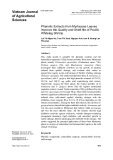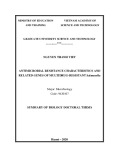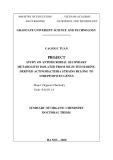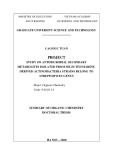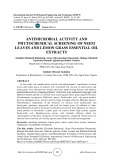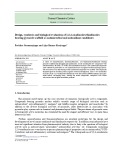Eur. J. Biochem. 269, 82–92 (2002) (cid:211) FEBS 2002
Purification and characterization of the human adenosine A2a receptor functionally expressed in Escherichiacoli
H. Markus Weiß and Reinhard Grisshammer*
MRC Laboratory of Molecular Biology, Hills Road, Cambridge, UK
that
hA2aR solubilized in dodecylmaltoside to be obtained, and, increased the stability of the receptor solubilized in other alkylmaltosides. Purification to homogeneity was achieved in three steps, including ligand a(cid:129)nity chroma- tography based on the antagonist xanthine amine con- gener. The purified hA2aR fusion protein bound [3H]ZM241385 with a Kd of 0.19 nM and an average Bmax of 13.7 nmolÆmg)1 suggests 100% functionality. Agonist a(cid:129)nities for the purified solubilized receptor were higher than those for the membrane-bound form. Su(cid:129)cient pure, functional hA2aR can now be prepared regularly for structural studies.
adenosine A2a
receptor; receptor; maltose-binding
[3H]ZM241385; protein
Keywords: G-protein-coupled fusion; functional solubilization.
The adenosine A2a receptor belongs to the seven trans- membrane helix G-protein-coupled receptor family, is abundant in striatum, vasculature and platelets and is involved in several physiological processes such as blood pressure regulation and protection of cells during anoxia. For structural and biophysical studies we have expressed the human adenosine A2a receptor (hA2aR) at high levels inserted into the Escherichia coli inner membrane, and established a purification scheme. Expression was in fusion with the periplasmic maltose-binding protein to levels of 10–20 nmol of receptor per L of culture, as detected with the specific antagonist ligand [3H]ZM241385. As the re- ceptor C-terminus was proteolyzed upon solubilization, a protease-resistant but still functional receptor was created by truncation to Ala316. Addition of the sterol, cholesteryl hemisuccinate, allowed a stable preparation of functional
mation on the bound ligand conformation obtained by NMR spectroscopy, would assist in the design of subtype specific compounds and improve the understanding of GPCR function.
GPCRs constitute a large protein family, but from the thousands of members, only rhodopsin has been purified in large quantities from natural tissue. Functional heterolo- gous expression and purification of large quantities of GPCRs has proved to be very difficult [7–10]. Crystalliza- tion, NMR spectroscopy, and other work that depends on milligram quantities of purified protein, are therefore hindered. Structure determination of GPCRs is successful when sufficient pure protein is available, as shown for rhodopsin [11–13]. Hence, functional over-expression and stable purification are the keys to more rapid progress in understanding GPCR structure and function.
Adenosine is a paracrine modulator of cell function that is important for local regulatory processes in virtually all mammalian organs. Adenosine is involved in protection of cells during anoxia and is an ubiquitous neuromodulator in the central nervous system [1–4]. So far, four human adenosine receptors have been identified (A1, A2a, A2b, and A3) belonging to the family of G-protein-coupled receptors (GPCRs). Like many other GPCRs, adenosine receptors are potential drug targets. Drugs acting on the human adenosine A2a receptor (hA2aR) are expected to have a therapeutic potential in CNS disorders, inflammation or stroke [5]. Mice lacking the adenosine A2a receptor show increased aggression, hypoalgesia, faster platelet aggrega- tion, high blood pressure and reduced exploratory activity indicating involvement of the receptor in a variety of physiological functions [6]. Direct structure determination of hA2aR by X-ray or electron crystallography, or infor-
No well documented purification of functional adenosine A2a receptor and characterization of the purified protein has yet been reported. The A2a receptor has been heterologously expressed but purified only in small amounts for antibody production [14]. The purification of microgram quantities of adenosine A1 receptor from different tissues has been reported previously based on efficient ligand affinity chro- matography using the antagonist xanthine amine congener (XAC) [15–17], but this procedure has never been used for the adenosine A2a receptor.
We report here the expression of the hA2aR fused at its N-terminus with the maltose-binding protein (MBP) and its purification in milligram quantities. The receptor is fully functional according to ligand binding analysis. This is the first purification of an adenosine receptor in a functional form and in sufficient quantity for structural and biophysical work.
Correspondence to H. M. Weiß, Aesku.lab Diagnostika, Mikroforum Ring 2, 55234 Wendelsheim, Germany. Fax: + 49 6734 9627 27, Tel.: + 49 6734 9627 11, E-mail: weiss@aeskulab.de Abbreviations: CHS, cholesteryl hemisuccinate; DDM, n-dodecyl-b-D- maltoside; DeM, n-decyl-b-D-maltoside; GPCR, G-protein-coupled receptor; hA2aR, human adenosine A2a receptor; IMAC, immobilized metal a(cid:129)nity chromatography; IPTG, isopropyl thio-b-D-galactoside; MBP, maltose-binding protein; NECA, 5¢-N-ethylcarboxamidoade- nosine; R-PIA, R(–)N6-(2-phenylisopropyl)-adenosine; UM, n-undecyl-b-D-maltoside; XAC, xanthine amine congener. *Present address: Laboratory of Molecular Biology, NIDDK, NIH, Building 50/4503, 50 South Drive, Bethesda, MD 20892-8030, USA. (Received 6 August 2001, accepted 22 October 2001)
(cid:211) FEBS 2002
Purification and characterization of A2a receptor (Eur. J. Biochem. 269) 83
M A T E R I A L S A N D M E T H O D S
Materials
[3H]ZM241385 (629 GBqÆmmol)1) and ZM241385 were obtained from Tocris (Bristol, UK). Theophylline, XAC, R(–)N6-(2-phenylisopropyl)-adenosine (R-PIA), and 5¢-N- ethylcarboxamidoadenosine (NECA) were purchased from Sigma RBI. Chelating Sepharose, HiTrap Q Sepharose, PD10 and NICK spin columns were from Amersham Pharmacia (Uppsala, Sweden), Ni-nitrilotriacetic acid aga- rose was from Qiagen (Hilden, Germany) and Affi-Gel 10 gel was from Bio-Rad (Hercules, CA, USA). Adenosine deaminase was purchased from Boehringer (Mannheim, Germany). Cholesteryl hemisuccinate (CHS) was from Sigma, n-dodecyl-b-D-maltoside (DDM) was from Ana- trace (Maume, OH, USA) and n-undecyl-b-D-maltoside (UM) and n-decyl-b-D-maltoside (DeM) were from Calbio- chem (Nottingham, UK). The cDNA coding for hA2aR [18] was generously provided by J. Coote (GlaxoWellcome, Stevenage, UK).
Expression of hA2aR fusion proteins
then briefly with dimethylsulfoxide before adding it to the XAC solution (12 mL XAC in dimethylsulfoxide for 1 mL of packed gel). The suspension was slowly stirred overnight at room temperature. The amount of covalently bound XAC was estimated to be about 14 lmol per mL of gel by monitoring the absorbance at 310 nm in 10 mM HCl of the XAC solution before and after incubation with the gel. This is about eight times more ligand per volume of gel than reported by Nakata [15]. The gel was washed with dimethylsulfoxide and then extensively with buffer (50 mM Tris/HCl, pH 7.4), before finally being washed and stored in 20% ethanol.
Membrane preparation and solubilization from membranes
Escherichia coli strain DH5a (Gibco BRL) [19] was used as the host for recombinant plasmids. Cells were grown in 2 · TY medium [19] containing ampicillin (100 lgÆmL)1) and glucose (0.2%, w/v). The cDNA coding for the hA2aR [18] was modified by standard cloning techniques and PCR as follows. The start codon was replaced by a BamHI restriction enzyme site, encoding the amino-acid residues Gly-Ser, in-frame with the codon for Pro2 of the receptor cDNA. The codon for the last used amino acid of the receptor (Ser412 in case of the full-length receptor and Ala316 for the truncated receptor) was followed by the nucleotide sequence GCGGCCGCA that contains a NotI restriction site and encodes three Ala residues in the final construct. The regions coding for the C-terminal tags (Fig. 1) and two stop codons were flanked by NotI and HindIII restriction sites at the 5¢ and 3¢ ends, respectively. Cassettes were cloned into a pBluescript KS vector (Stratagene) and were confirmed by DNA sequencing. For obtaining the final expression vector, the cassettes were cloned as BamHI/HindIII fragments into the E. coli expression vector pRG/III-hs-MBP [20]. This vector con- tains the coding region for MBP including the N-terminal signal sequence; Thr366 is followed by a BamHI site used for introduction of the receptor cassette.
fluoride,
0.5 lgÆmL)1
1 mM phenylmethanesulfonyl fluoride,
For expression, cells with the respective expression vector were grown at 37 (cid:176)C in 2-L flasks containing 500 mL of 2 · TY medium supplemented with ampicillin (100 lgÆmL)1), glucose (0.2%, w/v) and theophylline (100 lM). At a D600 (cid:25) 0.7, isopropyl thio-b-D-galactoside (IPTG) was added to a final concentration of 0.3 mM and the temperature was reduced to 22 (cid:176)C. Cells were harvested 22– 28 h later, frozen in liquid nitrogen, and stored at )70 (cid:176)C.
All work was carried out at 0–4 (cid:176)C. E. coli cells were thawed and resuspended in lysis buffer (20 mM Hepes/KOH, pH 7.4, 100 mM NaCl, 5 mM MgCl2, 1 mM phenyl- leupeptin, methanesulfonyl 0.7 lgÆmL)1 pepstatin, 20 lgÆmL)1 DNaseI) using 2–3 mL of buffer per gram of cells. The suspension was twice passed through a French press. Membranes were pelleted by centrifugation at 100 000 g for 1 h, suspended in buffer (50 mM Hepes/KOH, pH 7.4, 100 mM NaCl, 30% 0.5 glycerol, lgÆmL)1 leupeptin, 0.7 lgÆmL)1 pepstatin), snap-frozen in aliquots and stored at )70 (cid:176)C.
Solubilization of
Synthesis of XAC-agarose gel
The ligand affinity gel was prepared based on the method described by Nakata [15]. XAC was dissolved in dimethyl- sulfoxide at a concentration of 0.5 mgÆmL)1. Affi-Gel 10 resin was washed extensively with ice-cold isopropanol and
the hA2aR from membranes was carried out at a protein concentration of about 6 mgÆmL)1 in membrane solubilization buffer (50 mM Hepes/KOH, pH 7.4, 200 mM NaCl, 30% glycerol, 40 lM theophylline, 1 mM phenylmethanesulfonyl fluoride, 0.5 lgÆmL)1 leu- peptin, 0.7 lgÆmL)1 pepstatin and 1% of the respective detergent (DDM, UM or DeM) with or without 0.2%
Fig. 1. hA2aR-fusion proteins used in this study. (A) Schematic repre- sentation of hA2aR fusion proteins. The boxes shown are not drawn to scale. The names used in the text are given on the right. MBP, mature E. coli maltose-binding protein (Lys1 to Thr366) followed by glycine and serine encoded by a BamHI restriction site; hA2aR, human adenosine A2a receptor (Pro2 to Ser412); hA2aRTr316, C-terminally truncated human adenosine A2a receptor (Pro2 to Ala316); TrxA, E. coli thioredoxin (Ser2 to Ala109); H10, 10 histidine residues; H10F, 10 histidine residues followed by the Flag-peptide. (B) C-terminal tags. Amino-acid residues are given in the one-letter code. The sequence AAA is encoded by a NotI restriction site, the sequence GT is encoded by a KpnI site, the sequence EF is encoded by a EcoRI site, the sequence DYKDDDDK corresponds to the Flag peptide.
84 H. M. Weiß and R. Grisshammer (Eur. J. Biochem. 269)
(cid:211) FEBS 2002
CHS. After incubation with slow rotation for 1 h at 4 (cid:176)C, samples were centrifuged for 45 min at 125 000 g. The supernatant was saved as the solubilized fraction. Aliquots were used for ligand binding assays.
Receptor solubilization from intact cells and purification
solution
(5 M),
14 mL NaCl
A prepacked 5 mL HiTrap Q Sepharose column was washed with 25 mL of buffer QA (50 mM Hepes/KOH, pH 7.4, 50 mM NaCl, 30% glycerol, 0.05% DDM, 0.01% CHS) followed by 25 mL of buffer QB (50 mM Hepes/ KOH, pH 7.4, 1 M NaCl, 30% glycerol, 0.05% DDM, 0.01% CHS) and then equilibrated with 30 mL of buffer QA. The sample (140 mL) was loaded at 1.5 mLÆmin)1. After washing with 60 mL of buffer QA at 2.5 mLÆmin)1, the receptor was eluted with 14% of buffer QB (183 mM NaCl) at 1 mLÆmin)1 and 1.5 mL fractions were collected. Peak fractions were pooled and concentrated using an Ultrafree-15 centrifugal concentrator (50 000 molecular weight cut-off, Millipore). Concentrated material was either used immediately for 2D crystallization trials (not shown), stored at 4 (cid:176)C, or frozen in liquid nitrogen for long-term storage.
Radioligand binding
and
specific
receptor
the A2a
low temperature (0–4 (cid:176)C)
2.5–3.2 mM theophylline. Adenosine included in all assays
All binding assays were carried out in polystyrol tubes using LBA buffer (20 mM Hepes/KOH, pH 7.4, 100 mM NaCl) antagonist [3H]ZM241385. Samples were incubated on ice unless stated otherwise. The incubation time was 3 h for compe- tition binding assays, 1.5 h for one-point saturation assays and for saturation experiments, and 1 h for saturation experiments performed at room temperature. These times were sufficient to reach equilibrium as association and dissociation of ZM241385 to the A2a receptor is fast [21] (data not shown). even at Nonspecific binding was determined in the presence deaminase of (0.5 UÆmL)1) was to remove adenosine, except for saturation and competition binding experiments on purified receptor.
Amounts of tritiated antagonist were determined by liquid scintillation counting. Binding data were analysed by nonlinear least-squares fitting using the program GRAPHPAD PRISM. Competition curves were fitted to the four-parameter logistic function.
Assays on membrane-bound receptors. For one-point saturation assays, membranes or E. coli cells were incubated in a total volume of 400 lL containing 6–9 nM [3H]ZM241385. Competition binding assays using mem- branes were performed in a final volume of 1.2 mL with [3H]ZM241385 at a concentration of 0.75 nM. In saturation experiments on membranes, the total volume was 1.5 mL. Bound and free ligand were separated by rapid vacuum filtration over GF/B filters soaked in 0.3% polyethyleni- mine. Filtration was carried out with a Brandel cell harvester at 4 (cid:176)C. Filters were washed three times with ice-cold buffer (20 mM Hepes/KOH, pH 7.4). For calcula- tion of the parameter (cid:212)receptors per cell(cid:213), the number of cells growing in suspension was estimated by measuring D600: a D600 of 1 was assumed to correspond to 109 cellsÆmL)1.
0.25 lgÆmL)1
fluoride,
All work was performed at 0–4 (cid:176)C. One-hundred grams of E. coli cells expressing M-A2aTr316-H10 (from 9 L of culture) were thawed and resuspended, using a Kenwood BL350 blender, in 175 mL of buffer (100 mM Hepes/KOH, pH 7.4, 60% glycerol) supplemented with 700 lL leupeptin 0.25 mgÆmL)1), 700 lL pepstatin (stock (0.35 mgÆmL)1), 700 lL phenylmethanesulfonyl fluoride (500 mM), 200 lL DNaseI (10 mgÆmL)1), 700 lL theophylline (25 mM) and 1.75 mL MgCl2 (1 M). Water was added afterwards to give a final volume of 315 mL. Then 35 mL of detergent stock solution (10% DDM, 2% CHS) were added with stirring. The suspension was sonicated with stirring on ice, using a sonicator ultrasonic processor XL (Misonix, Farmingdale, NY, USA), level 5, pulsing 1 s on/1 s off, with 12 s pulsing on per gram of cells. Then the suspension was stirred for 30 min on ice and centrifuged at 100 000 g for 1 h. The supernatant (about 300 mL) was supplemented with protease inhibitors (concentrations as above) and then added in batch to 50 mL of chelating Sepharose, loaded with Ni2+ ions and equili- brated in buffer NiA (50 mM Hepes/KOH, pH 7.4, 200 mM NaCl, 30% glycerol, 50 mM imidazole, 0.1% DDM, 0.02% CHS), resulting in a final imidazole concentration of less than 15 mM. The suspension was slowly stirred for 3 h and then packed into an Econo-column (Bio-Rad) with 5 cm diameter. The resin was washed at 9 mLÆmin)1 with 600 mL of buffer NiA supplemented with protease inhibitors (see above). Bound receptor was eluted with 150 mL of buffer NiB (50 mM Hepes/KOH, pH 7.4, 200 mM NaCl, 30% glycerol, 400 mM imidazole, 0.1% DDM, 0.02% CHS, 0.5 mM phenylmethanesulfonyl fluoride, 0.25 lgÆmL)1 leu- peptin, 0.35 lgÆmL)1 pepstatin) at 5 mLÆmin)1. NaCl and imidazole concentrations were reduced by adding 150 mL of buffer XDil (50 mM Hepes/KOH, pH 7.4, 30% glycerol, 0.1% DDM, 0.02% CHS, 0.5 mM phenylmethanesulfonyl fluoride, 0.25 lgÆmL)1 leupeptin, 0.35 lgÆmL)1 pepstatin) and the solution was passed through a 0.22-lm filter (Stericup, Millipore). XAC-agarose gel (10 mL), packed into an XK 26 column (Amersham Pharmacia), was equilibrated with buffer XA (50 mM Hepes/KOH, pH 7.4, 100 mM NaCl, 30% glycerol, 0.1% DDM, 0.02% CHS). The filtered sample (about 300 mL) was loaded onto the column overnight at 0.35 mLÆmin)1 and the column was washed at 0.8 mLÆmin)1 with about 60 mL of buffer XA supplemented with protease inhibitors. The receptor was eluted at 25 (cid:176)C in buffer XA, supplemented with 20 mM theophylline and protease inhibitors, at a flow rate of 0.6 mLÆmin)1. Due to the strong absorption of theophylline at 280 nm, elution could not be monitored spectroscopically. However, as judged from protein gels, the receptor was almost completely eluted after 70 mL of elution buffer. 70 mL of the XAC-agarose gel eluate were diluted with 70 mL of buffer QDil (50 mM Hepes/KOH, pH 7.4, 30% glycerol, 0.1% DDM, 0.02% CHS, 0.5 mM phenyl- leupeptin, methanesulfonyl 0.35 lgÆmL)1 pepstatin) and passed through a 0.22-lm filter.
Assays on solubilized receptors. Assays were performed in LBA buffer containing 0.1% DDM and 0.02% CHS in a volume of 200 lL (one-point saturation assays) or 300 lL (saturation and competition experiments). The concentra- tion of [3H]ZM241385 was 0.75 nM in competition assays
(cid:211) FEBS 2002
Purification and characterization of A2a receptor (Eur. J. Biochem. 269) 85
Radioligand binding-analyses on E. coli and P. pastoris membrane preparations, containing the S2 or the S4 somatostatin receptor fusion protein did not reveal specific binding of the agonist somatostatin. In contrast, the adenosine A1 receptor fusion proteins displayed high affinity binding of the antagonist [3H]8-cyclopentyl-1,3- dipropylxanthine in both expression systems; expression functional A1 receptor were 3–4 nmol and levels of 1–2 nmol per litre of shake flask culture in E. coli and in P. pastoris, respectively (data not shown).
and 12–18 nM in one-point saturation assays. Bound and free ligand were separated by gel filtration using NICK Spin columns. Columns were equilibrated in LBA buffer containing 0.1% DDM and 0.02% CHS, precooled to 4 (cid:176)C and precentrifuged for 3 min at 500 g (4 (cid:176)C). Aliquots of the assay mix (100 lL for one-point saturation assays, and 170 lL in saturation and competition exper- iments) were loaded and receptor-bound ligand was eluted by spinning at 630 g (4 (cid:176)C). Binding analysis on receptors solubilized in DeM or UM were performed as above except that DDM was substituted for 0.1% DeM or 0.1% UM in the assay mix and NICK Spin equilibration buffer. Theophylline, present in samples eluted from the ligand affinity column, was removed by gel filtration using PD10 columns equilibrated in buffer consisting of 20 mM Hepes/KOH, pH 7.4, 100 mM NaCl, 0.1% DDM and 0.02% CHS.
SDS/PAGE and N-terminal sequencing
Best expression levels, deduced from immunoblot- and radioligand binding-analyses, were achieved with the hA2aR using E. coli as the expression host. This receptor and expression system were therefore pursued. Expression of the hA2aR (construct M-A2a-H10F; Fig. 1) was suffi- ciently high to start purification. However, the receptor C-terminus was sensitive to proteolysis after solubilization. A second construct, M-A2a-TrxA-H10F (Fig. 1), allowed identification of the major C-terminal degradation product. This information was used to make a number of protease resistant constructs truncated at the C-terminus. One of those (M-A2aTr316-H10; Fig. 1) was used for the purifica- tion and characterization described here.
Proteins were incubated in sample buffer (125 mM Tris/ HCl, pH 8.1, 3.75% SDS, 12.5% glycerol, 6% 2-mercap- toethanol, 0.002% Bromophenol Blue) at room tempera- ture for at least 15 min and separated by SDS/PAGE on high-molarity Tris buffered gels [22]. For N-terminal sequencing, the protein was electro-blotted onto poly(viny- lidene difluoride) membranes (Immobilon-P, Millipore) as described previously [23]. Sequence analyses were per- formed with an Edman automated N-terminal protein sequencer (Procise 494, Applied Biosystems).
Protein assay and amino-acid analysis
Protein concentrations were determined by the Amido black assay [24] using BSA as a standard. For the purified receptor, amino-acid analysis was performed on a Biochrom 20 amino-acid analyser (Amersham Pharmacia) after hydrolysis in 6 M HCl for 18 h at 110 (cid:176)C. Comparing results from amino-acid analysis and Amido black assays indicated that the latter underestimated the amount of purified receptor fusion protein by 12%. Protein concen- trations of final purified receptor given in the text and tables have been corrected accordingly.
R E S U L T S
Culture conditions were optimized for functional expres- sion of hA2aR using the construct M-A2a-H10F (Fig. 1). Addition of glucose (0.2% (w/v) or more) to the medium increased the final cell density from an D600 of about 1.5 to a D600 of about 6. The number of receptors per cell, monitored by binding of [3H]ZM241385 to whole E. coli cells, increased about fourfold by including 0.2% glucose, but decreased again at higher glucose concentrations (0.4%). Addition of theophylline (50–100 lM) to the medium improved the expression level by another 10–30% per volume. Induction at a D600 of 0.6–1.0 was optimal whereas earlier induction resulted in poor cell growth. Neither the concentration of IPTG within a certain range (100 lM)1 mM), nor the use of different E. coli strains (BL21, CAG627, KS474), had a significant effect on expression levels. To achieve the highest levels of functional receptors, cells were grown for 22–28 h longer growth (40 h) did not improve after induction; expression further. The conditions described in the Materials and methods section resulted in receptor concentrations of 10–20 nmol per L of culture, or 1000–2000 receptors per cell. This corresponds to 17–34 pmol receptor per mg of mem- brane protein. Constructs coding for full-length receptors gave on average better expression than the truncated form used for purification.
Expression
Solubilization
For work aiming at structural and biophysical studies on GPCRs, high expression levels are essential. As the expres- sion level of a given receptor is difficult to predict, we performed an initial screen, expressing the cDNAs of four different human GPCRs (somatostatin receptors S2 and S4, and adenosine receptors A1 and A2a). Two expression systems were investigated. In E. coli, all four receptors were N-terminally fused to MBP, whereas in the yeast Pichia pastoris they were N-terminally fused to the a-factor prepropeptide (S2 and A1 receptors only). We employed vectors previously used for the successful expression at high levels of the rat neurotensin receptor in E. coli and of the mouse 5HT5A 5-hydroxytryptamine and human b2-adren- ergic receptors in P. pastoris [20,25]. All receptor fusion proteins could be detected by immunoblot-analyses.
Solubilization from membranes is necessary for purification of a membrane protein. However, for fragile membrane proteins such as GPCRs, it is difficult to find conditions that allow efficient extraction and maintain structural integrity. We used radioligand binding assays to monitor hA2aR integrity and stability. Approximately 70–90% of specific [3H]ZM241385 binding sites were solubilized from mem- brane preparations using DDM. Use of the shorter chain derivatives UM and DeM resulted in poorer recoveries, and the solubilized receptor was less stable (Fig. 2). Addition of the cholesterol derivative CHS to solubilization experiments increased the recovery to nearly 100% for all three alkylmaltoside detergents, and increased the stability of
86 H. M. Weiß and R. Grisshammer (Eur. J. Biochem. 269)
(cid:211) FEBS 2002
bound receptor was more resistant. Proteolysis could be reduced by neither the use of protease deficient E. coli strains (CAG 627, KS 474), nor with additional protease inhibitors (DFP, Pefabloc, a2 macroglobulin, complete protease inhibitor mix (Boehringer), (4-amidinophenyl)- methanesulfonyl fluoride, results not shown). IMAC start- ing with solubilized M-A2a-TrxA-H10F fusion protein allowed the isolation of a C-terminal degradation product that was subject to N-terminal sequence analysis. The resulting amino-acid sequence Leu-Val-Ser-Gly-Gly-Ser- Ala-Gln is found in the receptor C-terminus starting from Leu365. As shortening of the C-terminus by 95 residues has been shown to affect neither ligand binding properties nor adenylate cyclase activation nor functional desensitization [26], we focused on the fusion protein M-A2aTr316-H10 where the C-terminus is truncated by 95 residues. This truncated fusion protein was purified without any sign of proteolytic degradation.
Purification
receptors solubilized in UM and DeM (Fig. 2). Receptor half-lives in the solubilized fraction (deduced from two experiments, one of which is given in Fig. 2) were 7 days using DeM, 26 days using UM and 40–130 days using DDM. When CHS was employed in combination with any of the three alkylmaltosides, half-lives were in the range 40–130 days. Both the full-length hA2aR (M-A2a-H10F) and the truncated form (M-A2aTr316-H10) behaved identically in these experiments. For purification of M-A2aTr316-H10, solubilization was carried out with DDM and CHS, starting with whole cells instead with membrane preparations. Recoveries were lower (50–60%); however, the time consuming membrane preparation and losses in this step (usually more than 40%) were avoided.
Truncation of the receptor C-terminus
Compared to other members of the rhodopsin family, hA2aR has a long C-terminus consisting of amino acids 294–412 [26]. Its susceptibility to proteolysis has been discussed previously [14,27]. Immunoblot analysis indicated that the C-terminus of the fusion protein M-A2a-H10F was rapidly cleaved upon solubilization, whereas the membrane-
The optimized large-scale purification of the fusion protein M-A2aTr316-H10 from 100 g of E. coli cells is documented in Table 1 and Fig. 3. The final recovery from three preparations carried out on identical scale was 29 ((cid:139) 2)% of the total solubilized fraction. The experimental value for specific radioligand binding was 13.7 ((cid:139) 0.8) nmolÆmg)1, which is in agreement with the theoretical value of 13 nmolÆmg)1 for the 77-kDa fusion protein, assuming one ligand binding site per molecule. Purification of protein starting from 70 g of cells gave similar results. The following parameters were investigated to optimize the purification procedure. Batch loading of the IMAC resin resulted in much better recoveries (> 50%) compared to column loading (< 20%). Batch binding of the receptor fusion protein to the IMAC gel was relatively slow, requiring 3 h to achieve greater than 80% binding. The presence of E. coli thioredoxin between the truncated receptor C-terminus and the deca-histidine tag accelerated binding to the IMAC gel (data not shown), probably by improving the accessibility of the tag. However, this was not investigated further as good recoveries were achieved for M-A2aTr316-H10 by batch loading for 3 h using sufficient amounts of Ni2+ loaded chelating Sepharose. The binding capacity of the gel was found to be low ((cid:25) 100 lg of fusion protein per mL of gel as judged from specific [3H]ZM241385 binding). The binding capacity of Ni2+ loaded chelating Sepharose was slightly higher compared to that of Ni-nitrilotriacetic acid agarose but so was the background binding.
Fig. 2. Solubilization and stability of hA2aR (M-A2aTr316-H10) in di(cid:128)erent alkylmaltosides, with or without addition of CHS. Solubiliza- tion from membranes and one-point saturation assays were carried out as described in the Materials and methods section. Solubilized frac- tions were stored at 4 (cid:176)C in membrane solubilization bu(cid:128)er for the time indicated. Solubilization was in 1% DeM (j,h), 1% UM (.,,) or 1% DDM (d,s) with (filled symbols) or without (open symbols) the addition of 0.2% CHS. In many cases, the error bars are smaller than the symbols. Results shown are from one of two experiments.
Table 1. Purification of the fusion protein M-A2aTr316-H10 from 100 g of E. coli cells (data from one representative experiment). The purification was performed as described in the Materials and methods section. Total receptor was determined by one-point saturation binding of [3H]ZM241385. Total protein was determined with the Amido black assay [24] and this was corrected by the results from amino-acid analysis (+ 12%) for the purified receptor (Q Sepharose eluate).
Total receptor (pmol) Relative yield (%) Protein concn (mgÆmL)1) Total protein (mg) Specific binding (pmolÆmg)1) Purification (fold)
7306 9.7 1 84
Solubilized material IMAC eluate XAC flow through XAC eluate Q Sepharose eluate 70896 43790 8735 23657 18091 100 62 (12) 33 26 24.6 0.35 0.128 0.045 0.200 53.6 44.8 3.2 1.5 817 195 7393 12061 – 762 1243
(cid:211) FEBS 2002
Purification and characterization of A2a receptor (Eur. J. Biochem. 269) 87
Fig. 3. Purification of hA2aR (M-A2aTr316-H10) from E. coli cells. The purification was performed as described in the Materials and methods section and is quantitatively documented in Table 1. The following fractions were analysed by 10% SDS/PAGE and silver staining. Lane 1, high molecular mass standard (Sigma); lane 2, 1.5 lg of the solubilized fraction; lane 3, 0.5 lg of IMAC eluate; lane 4, 0.5 lg of XAC flow through; lane 5, 0.2 lg of XAC eluate; lane 6, 0.2 lg of Q Sepharose eluate (eluted with 14% bu(cid:128)er QB, final purified fraction); lane 7, 0.2 lg of protein eluted with 100% bu(cid:128)er QB from the Q Sepharose.
65 kDa (Fig. 3, lane 6), which deviates by 12 kDa from the calculated value of 77 kDa. To show that this resulted from frequently observed with atypical running behaviour, membrane proteins, rather than from proteolysis, we verified the identity of the hA2aR fusion protein by specific radioligand binding (see below), N-terminal sequencing and amino-acid analysis. The sequence obtained, namely Lys- Ile-Glu-Glu-Gly-Lys-Leu-Val-Ile-Trp corresponds to the N-terminus of the mature maltose-binding protein. Binding of the fusion protein to the IMAC gel in buffer containing 50 mM imidazole indicates the presence of the C-terminal histidine tag. We conclude that the 65-kDa band observed in SDS acrylamide gels corresponds to the 77-kDa fusion protein.
IMAC purified M-A2aTr316-H10 bound almost quantita- tively to the ligand affinity matrix when loaded slowly (0.23 mLÆmin)1, Fig. 4), indicating that the majority of the receptor protein was correctly folded. For scaling up, flow rates were increased to 0.35 mLÆmin)1 to allow the prepa- ration to be completed within 2 days, leading to slightly poorer binding to the XAC-agarose (Fig. 3; Table 1). Elution from the ligand affinity column was slow even at increased temperature (25 (cid:176)C) resulting in a dilute eluate. The low affinity antagonist theophylline was used for elution as high affinity hA2aR antagonists are hardly soluble in aqueous buffers. In some experiments the antagonist ZM241385 was used for elution. However, it was found to bind nonspecifically to the XAC-agarose. Theophylline was removed by gel filtration before quanti- fying specific [3H]ZM241385 binding in the XAC-agarose eluate. The value obtained was only 50–80% of the theoretical value calculated for pure and fully functional receptor. Possible reasons for this finding are: (a) quanti- fication of binding sites is inaccurate (presence of theoph- ylline) or (b) denaturation of some receptor due to the increased temperature used for elution from the ligand column. However, the final ion-exchange step increased the specific radioligand binding to its theoretical value. This might result from the complete removal of theophylline in this step or the separation of denatured protein from functional receptor. Indeed, receptor protein with low specific binding (0.2–8 nmolÆmg)1) is eluted from the ion- exchange column at high salt concentrations (Fig. 3, lane 7).
Integrity and stability of the purified protein M-A2aTr316-H10
The purified receptor runs in SDS/PAGE gels as a single, slightly diffuse band with an apparent molecular mass of
When stored at 4 (cid:176)C in buffer consisting of 50 mM Hepes/KOH, pH 7.4, 200 mM NaCl, 30% glycerol, 0.1% DDM and 0.02% CHS, specific [3H]ZM241385 binding of the purified receptor decreased to 81% over 40 days corresponding to a half-life of 3.5–6.0 months (one exper- iment, five time points). In another experiment, the influence of specific ligands on the stability of purified receptor was tested at 4 (cid:176)C in buffer consisting of 50 mM Hepes/KOH, pH 7.4, 100 mM NaCl, 6% glycerol, 0.05% DDM and 0.01% CHS. Ligands were added at concentrations of 10–20 times their Ki value. Without ligand, a half-life of 33 days was obtained. This increased to 77 days in the presence of NECA (agonist) and 53 days in the presence of theophylline (antagonist) (one experiment, eight time points over a period of 116 days, a one-phase exponential decay curve was fitted to the data). Addition of the antagonist CGS15943 had no effect.
Fig. 4. E. coli expressed and solubilized hA2aR (M-A2aTr316-H10) binds specifically and quantitatively to a XAC-agarose gel. Shown is a section of a 10% silver-stained SDS/PAGE gel. Lane 1, 0.4 lg of the fraction loaded onto the XAC-agarose (IMAC purified); lane 2, 0.4 lg of the XAC-agarose flow through fraction; lane 3, 0.2 lg of protein eluted with 20 mM theophylline. The arrow points to the M-A2aTr316-H10 fusion protein. Note that the main contamination, seen in lane 1, runs only marginally above the hA2aR fusion protein and is the main band in lane 2. In this purification, 7% of specific ligand binding sites loaded onto the XAC-agarose were detected in the flow through fraction. The purification was carried out as outlined in the Materials and methods section but starting from 70 g of cells. Ni-nitrilotriacetic acid agarose was used for the IMAC step and washing and elution were carried out with 35 and 200 mM imidazole, respectively. The XAC-agarose was loaded at a flow rate of 0.23 mLÆmin)1.
88 H. M. Weiß and R. Grisshammer (Eur. J. Biochem. 269)
(cid:211) FEBS 2002
Significance of CHS for receptor stability during purification
DDM-solubilized M-A2aTr316-H10 (no CHS added) had a half-life of more than 40 days when stored at 4 (cid:176)C (Fig. 2, s). However, subsequent purification performed in DDM without CHS resulted in low recovery of functional receptor (0.4 nmol of specific [3H]ZM241385 binding sites, starting from 54 nmol). Despite near homogeneity, as seen on SDS/PAGE gels, the DDM-purified receptor displayed low values for specific binding (465 pmolÆmg)1), indicating loss of receptor functionality.
A detailed investigation showed that CHS was essential to maintain receptor functionality during the course of purification. The half-live of DDM-solubilized receptor was reduced to less than 1 day by enrichment using IMAC (Fig. 5, j). Addition of CHS during solubilization and into the purification buffers increased the stability of IMAC purified receptor by at least 20-fold (Fig. 5B, s). Addition of CHS during solubilization, but not during the subsequent IMAC step, was not sufficient to maintain the receptor stable (Fig. 5B, m).
The presence of CHS not only improved solubilization recoveries using different alkylmaltoside detergents (Fig. 2), but also allowed a pure and stable receptor preparation to be achieved.
Ligand binding studies
The quantification of interactions with specific ligands allows the structural integrity and homogeneity of a purified receptor protein to be judged. The M-A2aTr316-H10 fusion protein displayed high affinity binding to all ligands tested both in membrane-bound and purified form. Affinities to agonists were about one order of magnitude higher for the purified receptor compared to those for the membrane- bound form, whereas antagonist affinities were similar in both cases (Table 2).
(Fig. 6C) with
value
a Kd
Ligand binding on purified receptor protein was carried out at 0–4 (cid:176)C to avoid receptor denaturation at higher temperatures. Binding to membrane-bound receptors was performed on ice and at room temperature. Purified receptors displayed a single affinity for the antagonist [3H]ZM241385 of 0.19 (cid:139) 0.02 nM and a Bmax value of 12.4 (cid:139) 0.5 nmolÆmg)1 (n (cid:136) 3). In contrast, data from saturation experiments on
Fig. 5. The stability of solubilized hA2aR (M-A2aTr316-H10) during purification is dependent on the presence of CHS. (A) Solubilized frac- tion. (B) IMAC purified fraction. Solubilization and purification by IMAC was performed as described in the Materials and methods section starting with 10 g of cells for each condition described. Sus- pension of cells for solubilization was achieved using a potter instead of a blender. Ni-nitrilotriacetic acid agarose was used for the IMAC step. Washing and elution were carried out with 35 and 200 mM imidazole, respectively. One-point saturation assays with [3H]ZM241385 were performed as outlined in the Materials and methods section, with 0.02% CHS in all binding assays. The results shown are from one of two independent experiments. In many cases, the error bars are smaller than the symbols. j, no CHS added for solubilization and purifica- tion; m, 0.2% CHS in solubilization bu(cid:128)er and no CHS in bu(cid:128)er NiA and NiB; s, 0.2% CHS in solubilization bu(cid:128)er and 0.02% in bu(cid:128)ers NiA and NiB.
Table 2. Pharmacological profile of M-A2aTr316-H10 in membrane-bound and purified form. Values are from at least two independent experiments analysed using the four-parameter logistic function and given as mean (cid:139) standard error. Membrane preparation, purification and competition experiments were carried out as outlined in the Materials and methods section. Incubation of assays was on ice for 3 h with [3H]ZM241385 at a concentration of 0.75 nM. Ki values for binding to the purified receptor were calculated according to Cheng & Pruso(cid:128) [53] with a Kd for [3H]ZM241385 of 0.19 nM.
Membrane-bound receptor Purified receptor
n n Ligand IC50 (M) IC50 (M) Ki (M)
3.6 (cid:139) 0.2 · 10)6 6.5 (cid:139) 0.4 · 10)5 0.73 (cid:139) 0.04 0.87 (cid:139) 0.18 3.9 (cid:139) 0.2 · 10)7 6.5 (cid:139) 0.1 · 10)6 7.9 · 10)8 1.3 · 10)6 0.96 (cid:139) 0.06 1.01 (cid:139) 0.02 Agonists NECA R-PIA Antagonists
Theophylline XAC 2.3 (cid:139) 0.3 · 10)5 1.7 (cid:139) 0.4 · 10)7 0.94 (cid:139) 0.11 0.96 (cid:139) 0.06 1.3 (cid:139) 0.3 · 10)5 1.6 (cid:139) 0.2 · 10)7 2.7 · 10)6 3.2 · 10)8 1.19 (cid:139) 0.15 1.12 (cid:139) 0.11
(cid:211) FEBS 2002
Purification and characterization of A2a receptor (Eur. J. Biochem. 269) 89
ice, using membrane-inserted receptors were significantly (P < 0.01) better fitted assuming two binding sites (five out of six experiments) with a Kd1 value of 0.10 (cid:139) 0.03 nM (44 (cid:139) 5% of binding sites) and a Kd2 value of 1.42 (cid:139) 0.47 nM (56 (cid:139) 5% of binding sites) (Fig. 6A). However, at room temperature, membrane-bound receptors displayed only one affinity for the antagonist (Kd value of 0.65 (cid:139) 0.02 nM, n (cid:136) 2) (Fig. 6B). Bmax values for mem- brane-bound receptors were 10–20% higher when measure- ments were carried out on ice rather than at room temperature.
for
Unlabeled adenosine receptor ligands, tested at 0 (cid:176)C, inhibited specific [3H]ZM241385 binding to both mem- brane-bound and purified hA2aR by more than 90% at the highest concentrations used (6.7 mM theophylline, 200 lM XAC, 2 mM NECA, 2 mM R-PIA; Fig. 7). The agonist NECA bound with higher affinity to membrane-bound and purified hA2aR than the agonist R-PIA, which is a typical feature of the adenosine A2a receptor. The rank order of potency for the purified receptor (XAC > NECA > R-PIA > theophylline; Fig. 7B; Table 2) is identical to that reported for membrane-bound hA2aR expressed in CHO cells [28,29]. In contrast, the rank order was found to be the membrane-bound M-A2aTr316-H10 different receptor (XAC > NECA > theophylline > R-PIA; Fig. 7A). Pseudo-Hill coefficients, derived from agonist competition curves on membrane-bound receptors, were smaller than unity, despite the absence of G proteins in E. coli. For antagonist competition curves, pseudo-Hill coefficients were (cid:25) 1. A similar behaviour, with agonist, but not antagonist, pseudo-Hill coefficients < 1 and no guanine nucleotide effect, was reported for the dopamine D2S receptor expressed in insect cells [30]. All competition curves obtained for purified receptors displayed pseudo-Hill coef- ficients (cid:25) 1.
Fig. 6. Saturation binding of [3H]ZM241385 to membrane-bound and purified hA2aR (M-A2aTr316-H10). Membrane preparation, receptor puri- fication and ligand binding analyses were performed as outlined in the Materials and methods section. The results shown are from one of six (A), two (B) or three (C) experiments performed in duplicate. In many cases, the error bars are smaller than the symbols. (A) Saturation binding to membrane-bound M-A2aTr316-H10 at 0–4 (cid:176)C. (B) Saturation binding to membrane-bound M-A2aTr316-H10 at room termperature ((cid:25) 25 (cid:176)C). (C) Saturation binding to purified M-A2aTr316-H10 at 0–4 (cid:176)C. Insets: Scatchard transformation of the binding data. B, bound; F, free. Kd values determined by nonlinear least-squares fitting are given in the results section.
D I S C U S S I O N
Purification of a hA2aR fusion protein (M-A2aTr316-H10), expressed in E. coli, resulted in 1.5 mg of homogenous, fully functional protein from 100 g of wet cells. The amount of purified receptor protein is at least 100-fold greater than that for adenosine A1 receptor obtained from different tissues or
Fig. 7. Displacement of [3H]ZM241385 binding to membrane-bound and purified hA2aR (M-A2aTr316-H10). Membrane preparation, receptor purification and ligand binding analyses were performed as outlined in the Materials and methods section. Incubation was on ice for 3 h in LBA bu(cid:128)er which was supplemented with 0.1% DDM/ 0.02% CHS for the analysis of purified receptors. [3H]ZM241385 was present at a concentration of 0.75 nM. The results shown are from one of at least two independent experiments. Ligands used for displace- ment were: m, NECA; j, R-PIA; ,, theophylline; s, XAC. (A) Displacement curves for membrane-bound M-A2aTr316-H10. (B) Displacement curves for purified M-A2aTr316-H10. IC50 values for the displacing drugs are given in Table 2.
90 H. M. Weiß and R. Grisshammer (Eur. J. Biochem. 269)
(cid:211) FEBS 2002
for tagged A1 receptor purified from stably transfected CHO cells [17,31]. To date, no quantified purification of the adenosine A2a receptor has been reported. The availability of milligram quantities of functional M-A2aTr316-H10 fusion protein will allow extensive crystallization trials.
Chaps [40] that lost 45% of binding sites within 15 days. CHS has been beneficial for the stability of solubilized somatostatin receptor from pancreatic acinar cells [42], for purification of the rat neurotensin receptor [20] and for functional solubilization of the mouse 5HT5a hydroxytryp- tamine receptor expressed in yeast [43]. The beneficial effects of CHS on receptor integrity could be due to its structural similarity to cholesterol for which a direct or indirect influence on receptor function has been shown for a number of GPCRs [44,45]. CHS in combination with different alkylmaltosides is thus an alternative to digitonin in functional purification of GPCRs. However, preliminary results from analytical gel filtration experiments show that addition of CHS results in broad peaks indicating a substantial heterogeneity in micelle size.
the
step to capture
The adenosine A2a receptor is expressed to high levels in a form in insect cells using the baculovirus functional expression system [32]. In contrast, expression levels in mammalian cells are low [28,29]. We have achieved expression of correctly folded hA2aR in E. coli by using a vector system optimized for expression of functional GPCRs [20,33]. The level of functional expression is amongst the highest reported for a GPCR in the E. coli system [7,8,10]. Remarkably, the fraction of correctly folded receptors in the solubilized material was close to 100% as indicated by the high degree of specific binding to a ligand affinity column (Fig. 4). In contrast, a high proportion of misfolded protein in membranes and sometimes also in the solubilized fraction is reported for some membrane proteins expressed in insect cells [34,35]. Furthermore, the lack of glycosylation in E. coli excludes one source of heterogeneity and can therefore be considered as an advantage for crystallization.
Shortening of the hA2aR C-terminus was necessary in this work to achieve protease resistance and to allow a homogeneous receptor preparation. As shown previously in mammalian cells, a deletion after Ala316, corresponding to the truncation used in this study, did not influence receptor properties such as ligand binding, adenylate cyclase activa- tion and functional desensitization [26]. In agreement with this, previous work also showed that shortening of the C-terminus in combination with prevention of receptor glycosylation did not alter the ligand binding properties of the canine adenosine A2a receptor [27]. This indicates that the truncated receptor purified by us is sufficient to fulfil the main receptor functions and is appropriate for structural and biophysical investigations. Comparison of the amino- acid sequences of adenosine receptors with those of other GPCRs indicates that the C-terminus of the adenosine A2a receptor consists of about 120 amino acids, which compares to only 30–45 amino acids for the other three known adenosine receptors. The functional significance of this long C-terminus is so far unclear, but it is likely to be involved in A2a receptor specific protein–protein interactions.
Even in cases of good expression, a 250- to 2500-fold enrichment is typically necessary to purify a GPCR from a recombinant source. This level of purification is usually not possible in a single step [20,32,34,36]. We used IMAC as an efficient first fusion protein M-A2aTr316-H10. The deca-histidine tag allowed IMAC to be performed under more stringent conditions compared to shorter histidine tags, resulting in better enrichment [46]. However, in contrast to results obtained with a deca- histidine tagged neurotensin receptor [46], the binding of M-A2aTr316-H10 to Ni-nitrilotriacetic acid resin packed into a column was extremely poor, with recoveries not exceeding 20% testing a variety of conditions. In contrast, good binding was achieved by batch-loading allowing sufficient time. The subsequent ligand affinity step resulted in an almost homogenous preparation (Fig. 3, lane 5). A XAC-based affinity gel has been used for purification of adenosine A1 receptors [15–17] but not for enrichment of functional A2a receptors. The M-A2aTr316-H10 fusion protein bound very efficiently to the XAC gel (Fig. 4). Fast elution to give a high receptor concentration was difficult, and best results were obtained by increasing temperature and using high concentrations of the weak antagonist theophylline combined with low flow rates. The final ion- exchange step allowed removal of theophylline, and a reduction of volume and detergent concentration. The higher degree of receptor homogeneity obtained by the ion- exchange step will help crystallization. This step also allows fast detergent exchange in preparation for crystallization experiments.
The M-A2aTr316-H10 fusion protein was characterized by ligand binding analyses to judge its identity and integrity. Binding of the antagonist [3H]ZM241385 was specific and saturable for both membrane-bound and purified receptors. The Kd value obtained for the membrane-bound hA2aR fusion protein at room temperature (0.65 nM) is in good agreement with a Ki value of 0.8 nM measured at 25 (cid:176)C for the hA2aR expressed in HEK-293 cells [47]. In contrast to experiments performed at room temperature, two affinity states were resolved when binding assays were performed at 0–4 (cid:176)C (Fig. 6A,B). The rank order of potency was also found to be altered in competition experiments with membrane-bound receptor conducted at 0 (cid:176)C (Fig. 7, Table 2) compared to that reported for hA2aR assayed at higher temperature [28,29]. These observations are in agreement with data from binding experiments performed with membrane-bound adenosine A2a receptor at 21 and 0 (cid:176)C using a eukaryotic expression system [48]. The
Efficient functional extraction from membranes and stability of solubilized GPCRs are crucial to obtain sufficient protein for structural studies. Solubilization of functional GPCRs has in many cases been achieved with digitonin [15,36,37]. However, impurities and batch varia- tions make it unsuitable for reproducible purification and subsequent crystallization experiments [38]. In contrast, the alkylmaltosides employed in this study are chemically well defined and commercially available at high purity. The combination of the cholesterol derivative CHS and different alkylmaltosides allowed highly efficient solubilization of A2a receptor in functional form. The reported recoveries of specific ligand binding sites (100% from membranes and 50–60% from whole cells) compare favourably to the (cid:25) 25% solubilization efficiency of adenosine A2a receptor from striatal membranes obtained with Chaps/cholic acid, with Chaps and with digitonin [39–41]. Using our detergent combinations, hA2aR was much more stable in solubilized as well as purified form than A2a receptor solubilized with
(cid:211) FEBS 2002
Purification and characterization of A2a receptor (Eur. J. Biochem. 269) 91
observed changes could result from an altered membrane fluidity and lateral pressure on the membrane-bound receptor at low temperature, similar to effects due to a changed lipid composition [49,50].
Baldwin, Wasyl Feniuk (Glaxo Institute for Applied Pharmacology) and Mike Sheehan (GlaxoWellcome) for helpful discussions, and to Awinder Sohal, Richard Henderson and Chris Tate for comments on the manuscript and helpful discussions. This project was supported by GlaxoWellcome, AstraZeneca and the Medical Research Council (UK) with Link Grant G9712367.
R E F E R E N C E S
1. Fredholm, B.B. (1995) Purinoceptors in the nervous system. Pharmacol. Toxicol. 76, 228–239.
2. Poulsen, S.A. & Quinn, R.J. (1998) Adenosine receptors: new opportunities for future drugs. Bioorgan. Med. Chem. 6, 619–641. 3. Kobayashi, S. & Millhorn, D.E. (1999) Stimulation of expression for the adenosine A2A receptor gene by hypoxia in PC12 cells. J. Biol. Chem. 274, 20358–20365.
4. Nyce, J.W. (1999) Insight into adenosine receptor function using antisense and gene-knockout approaches. Trends Pharmacol. Sci. 20, 79–83. 5. Ongini, E. & Fredholm, B.B. (1996) Pharmacology of adenosine A2A receptors. Trends Pharmacol. Sci. 17, 364–372.
6. Ledent, C., Vaugeois, J.M., Schi(cid:128)mann, S.N., Pedrazzini, T., El Yacoubi, M., Vanderhaeghen, J.J., Costentin, J., Heath, J.K., Vassart, G. & Parmentier, M. (1997) Aggressivness, hypoalgesia and high blood pressure in mice lacking the adenosine A2a receptor. Nature 388, 674–678.
7. Grisshammer, R. & Tate, C.G. (1995) Overexpression of integral membrane proteins for structural studies. Q. Rev. Biophys. 28, 315–422.
The purified receptor displayed a single apparent affinity for each ligand tested, including [3H]ZM241385 (Table 2) and an identical rank order of potency as the hA2aR in CHO cell membranes (XAC > NECA > R-PIA > theophylline), determined by using agonist or antagonist radioligands [28,29]. Ki values for the purified receptor compare to Ki values determined for membrane-bound hA2aR on platelets or expressed in CHO cells [28,29] as follows. R-PIA: 1.3 lM (E. coli), 0.86 and 0.68 lM (CHO), 1.6 lM (platelets); NECA: 79 nM (E. coli), 66 nM (CHO), 30 nM (platelets); XAC: 32 nM (E. coli), 1 and 4 nM (CHO), 5 nM (platelets); theophylline: 2.7 lM (E. coli), 1.7 and 5 lM (CHO). The presence of 100 mM NaCl in our assays, but not in the assays performed with platelet and CHO cell membranes may explain the reduced affinity towards XAC. NaCl (100 mM) was shown to reduce binding of [3H]XAC (1 nM) to striatal A2a receptor by about 50% in membrane-bound and solubilized form and to reduce agonist binding [40]. Agonist affinities increased by one order of magnitude upon solubilization and purifica- tion, whereas antagonist affinities remained similar (Table 2). Increased agonist affinities of solubilized GPCRs have been observed before [37,51,52]. In case of the striatal adenosine A2a receptor high agonist affinity of solubilized receptor was believed to result from G protein coupling [39,41]. This was supported by a reversible reduction of the number of agonist binding sites by addition of GTP [39]. We conclude that solubilized A2a receptor fusion protein displays high agonist affinity in absence of G proteins.
8. Tate, C.G. & Grisshammer, R. (1996) Heterologous expression of G-protein-coupled receptors. Trends Biotechnol. 14, 426–430. 9. Reila¨ nder, H. & Weiß, H.M. (1998) Production of G-protein-
coupled receptors in yeast. Curr. Opin. Biotech. 9, 510–517. 10. Stanasila, L., Pattus, F. & Massotte, D. (1998) Heterologous expression of G-protein-coupled receptors: human opioid recep- tors under scrutiny. Biochimie 80, 563–571. 11. Schertler, G.F.X., Villa, C. & Henderson, R. (1993) Projection structure of rhodopsin. Nature 362, 770–772.
C O N C L U S I O N
12. Unger, V.M., Hargrave, P.A., Baldwin, J.M. & Schertler, G.F.X. (1997) Arrangement of rhodopsin transmembrane alpha-helices. Nature 389, 203–206.
13. Palczewski, K., Kumasaka, T., Hori, T., Behnke, C.A., Motoshima, H., Fox, B.A., Le Trong, I., Teller, D.C., Okada, T., Stenkamp, R.E., Yamamoto, M. & Miyano, M. (2000) Crystal structure of rhodopsin: a G protein-coupled receptor. Science 289, 739–745.
In this report we describe methods for the expression, solubilization and purification of a hA2aR fusion protein in quantity and quality sufficient for biophysical characteriza- tion and crystallization. The following points made the purification of large amounts of functional hA2aR possible: (a) finding conditions for high level functional expression of hA2aR; (b) creating a protease resistant receptor form; (c) finding conditions that allow solubilization and purification without denaturation; and (d) employing methods that allow good enrichment at large scale with minimal losses of functional receptor protein.
14. Rosin, D.L., Robeva, A., Woodard, R.L., Guyenet, P.G. & Linden, J. (1998) Immunohistochemical localization of adenosine A2A receptors in the rat central nervous system. J. Com. Neurol. 401, 163–186. 15. Nakata, H. (1989) Purification of A1 adenosine receptor from rat brain membranes. J. Biol. Chem. 264, 16545–16551.
16. Olah, M.E., Jacobson, K.A. & Stiles, G.L. (1990) Purification and characterization of bovine cerebral cortex A1 adenosine receptor. Arch. Biochem. Biophys. 283, 440–446. 17. Nakata, H. (1992) A(cid:129)nity chromatography in purification of A1 adenosine receptors. J. Chromatogr. 597, 335–343.
The hA2aR was characterized pharmacologically for the first time in purified form. The ligand binding properties of the purified receptor were found to be similar to those in its natural environment or expressed in an eukaryotic system. All purified protein molecules bound the tested ligands with one apparent affinity, indicating a high degree of confor- mational homogeneity. The methodology we describe opens the way to a wide range of biophysical and structural studies. We have started to use the purified material for 2D crystallization trials.
18. Furlong, T.J., Pierce, K.D., Selbie, L.A. & Shine, J. (1992) Molecular characterization of a human brain adenosine A2 receptor. Mol. Brain Res. 15, 62–66.
19. Sambrook, J., Fritsch, E.F. & Maniatis, T. (1989) Molecular Cloning: a Laboratory Manual, 2nd edn. Cold Spring Harbor Laboratory Press, Cold Spring Harbor, New York.
A C K N O W L E D G E M E N T S
20. Tucker, J. & Grisshammer, R. (1996) Purification of rat neuro- tensin receptor expressed in Escherichia coli. Biochem. J. 317, 891– 899.
21. Palmer, T.M., Poucher, S.M., Jacobson, K.A. & Stiles, G.L. (1995) 125I-4-(2-[7-Amino-2-{2-furyl}{1,2,4}triazolo{2,3-a}{1,3,5}- We thank Sew Peak-Chew for N-terminal sequencing and David Owen for the amino acid analysis. Jim Coote (GlaxoWellcome) has provided the receptor cDNAs and given valuable advice. We are grateful to Joyce
92 H. M. Weiß and R. Grisshammer (Eur. J. Biochem. 269)
(cid:211) FEBS 2002
triazin)5–yl–amino]ethyl) phenol, a high a(cid:129)nity antagonist radi- oligand selective for the A2a adenosine receptor. Mol. Pharmacol. 48, 970–974.
37. Ohtaki, T., Ogi, K., Masuda, Y., Mitsuoka, K., Fujiyoshi, Y., (1998) Kitada, C., Sawada, H., Onda, H. & Fujino, M. Expression, purification, and reconstitution of receptor for pitu- itary adenylate cyclase-activating polypeptide. J. Biol. Chem. 273, 15464–15473.
22. Fling, S.P. & Gregerson, D.S. (1986) Peptide and protein molec- ular weight determination by electrophoresis using a high-molarity tris bu(cid:128)er system without urea. Anal. Biochem. 155, 83–88. 23. Matsudaira, P. (1987) Sequence from picomole quantities of proteins electroblotted onto polyvinylidene difluoride membranes. J. Biol. Chem. 262, 10035–10038. 38. Parini, A. & Graham, R.M. (1989) Glycerol, sodium phosphate, and sodium chloride permit the solubilization and partial purifi- cation of rat hepatic alpha 1-receptors by 3-(3-cholamidylpropyl)- dimethylammonio-1-propanesulfonate. Anal. Biochem. 176, 375– 381.
24. Scha(cid:128)ner, W. & Weissmann, C. (1973) A rapid, sensitive, and specific method for the determination of protein in dilute solution. Anal. Biochem. 56, 502–514.
39. Nano(cid:128), C. & Stiles, G.L. (1993) Solubilization and characteriza- tion of the A2-adenosine receptor. J. Recept. Res. 13, 961–973. 40. Ji, X.D. & Jacobson, K.A. (1993) Solubilized rabbit striatal A2a-adenosine receptors: stability and antagonist binding. Arch. Biochem. Biophys. 305, 611–617.
25. Weiß, H.M., Haase, W., Michel, H. & Reila¨ nder, H. (1998) Comparative biochemical and pharmacological characterization of the mouse 5HT5A 5-hydroxytryptamine receptor and the human b2-adrenergic receptor produced in the methylotrophic yeast Pichia pastoris. Biochem. J. 330, 1137–1147.
41. Costa, B., Lucacchini, A. & Martini, C. (1998) A2a adenosine receptors: guanine nucleotide derivative regulation in porcine striatal membranes and digitonin soluble fraction. Neurochem. Int. 33, 121–129. 26. Palmer, T.M. & Stiles, G.L. (1997) Identification of an A2a adenosine receptor domain specifically responsible for mediating short-term desensitization. Biochemistry 36, 832–838.
42. Brown, P.J. & Schonbrunn, A. (1993) A(cid:129)nity purification of a somatostatin receptor-G-protein complex demonstrates spec- ificity in receptor-G-protein coupling. J. Biol. Chem. 268, 6668– 6676. 43. Weiß, H.M.
27. Piersen, C.E., True, C.D. & Wells, J.N. (1994) A carboxyl-termi- nally truncated mutant and nonglycosylated A2a adenosine receptors retain ligand binding. Mol. Pharmacol. 45, 861–870. 28. Dionisotti, S., Ongini, E., Zocchi, C., Kull, B., Arslan, G. & Fredholm, B.B. (1997) Characterization of human A2A adenosine receptors with the antagonist radioligand [3H]-SCH 58261. Br. J. Pharmacol. 121, 353–360. (1998) Produktion von G-protein-gekoppelten Rezeptoren in der methylotrophen Hefe Pichia pastoris und deren Charakterisierung und Reinigung, PhD Thesis, Johann Wolfgang Goethe-Universita¨ t, Frankfurt, Germany.
44. Albert, A.D., Young, J.E. & Yeagle, P.L. (1996) Rhodopsin– cholesterol interactions in bovine rod outer segment disk mem- branes. Biochim. Biophys. Acta 1285, 47–55.
29. Klotz, K.N., Hessling, J., Hegler, J., Owman, C., Kull, B., Fredholm, B.B. & Lohse, M.J. (1998) Comparative pharmacology of human adenosine receptor subtypes – characterization of stably transfected receptors in CHO cells. Naunyn-Schmiedeberg’s Arch. Pharmacol. 357, 1–9.
45. Gimpl, G., Burger, K. & Fahrenholz, F. (1997) Cholesterol as modulator of receptor function. Biochemistry 36, 10959–10974. 46. Grisshammer, R. & Tucker, J. (1997) Quantitative evaluation of neurotensin receptor purification by immobilized metal a(cid:129)nity chromatography. Prot. Exp. Purif. 11, 53–60. 30. Gru¨ newald, S., Haase, W., Reila¨ nder, H. & Michel, H. (1996) Glycosylation, palmitoylation, and localization of the human D2S receptor in baculovirus-infected insect cells. Biochemistry 35, 15149–15161.
47. Ongini, E., Dionisotti, S., Gessi, S., Irenius, E. & Fredholm, B.B. (1999) Comparison of CGS 15943, ZM 241385 and SCH 58261 as antagonists at human adenosine receptors. Naunyn-Schmiede- berg’s Arch. Pharmacol. 359, 7–10. 31. Gao, Z.H., Robeva, A.S. & Linden, J. (1999) Purification of A1 adenosine receptor-G-protein complexes: e(cid:128)ects of receptor down- regulation and phosphorylation on coupling. Biochem. J. 338, 729–736.
48. Luthin, D.R. & Linden, J. (1995) Comparison of A4 and A2a binding sites in striatum and COS cells transfected with adenosine A2a receptors. J. Pharmacol. Exp. Ther. 272, 511–518. 49. Epand, R.M. (1998) Lipid polymorphism and protein–lipid in- 32. Robeva, A.S., Woodard, R., Luthin, D.R., Taylor, H.E. & Linden, J. (1996) Double tagging recombinant A1- and A2A- adenosine receptors with hexahistidine and the FLAG epitope. Biochem. Pharmacol. 51, 545–555. teractions. Biochim. Biophys. Acta 1376, 353–368. 50. Cantor, R.S. (1999) Lipid composition and the lateral pressure profile in bilayers. Biophys. J. 76, 2625–2639. 33. Grisshammer, R., Duckworth, R. & Henderson, R. (1993) Expression of a rat neurotensin receptor in Escherichia coli. Biochem. J. 295, 571–576.
34. Kobilka, B.K. (1995) Amino and carboxyl terminal modifications to facilitate the production and purification of a G protein-coupled receptor. Anal. Biochem. 231, 269–271. 51. Pike, J.L. & Lefkowitz, R.J. (1978) Agonist-specific alterations in receptor binding a(cid:129)nity associated with solubilization of turkey erythrocyte membrane beta adrenergic receptors. Mol. Pharmacol. 14, 370–375.
52. Wikberg, J.E.S., Lefkowitz, R.J. & Caron, M.G. (1983) Solubili- zation of rat liver alpha1-adrenergic receptors. Biochem. Pharma- col. 32, 3171–3178.
35. Tate, C.G., Whiteley, E. & Betenbaugh, M.J. (1999) Molecular chaperones stimulate the functional expression of the cocaine- sensitive serotonine transporter. J. Biol. Chem. 274, 17551–17558. 36. Peterson, G.L., Toumadje, A., Johnson, W.C. & Schimerlik, M.I. (1995) Purification of recombinant porcine m2 muscarinic acetyl- choline receptor from chinese hamster ovary cells. J. Biol. Chem. 270, 17808–17814. 53. Cheng, Y. & Pruso(cid:128), W.H. (1973) Relationship between the inhibition constant (K1) and the concentration of inhibitor which causes 50 per cent inhibition (I50) of an enzymatic reaction. Biochem. Pharmacol. 22, 3099–3108.








